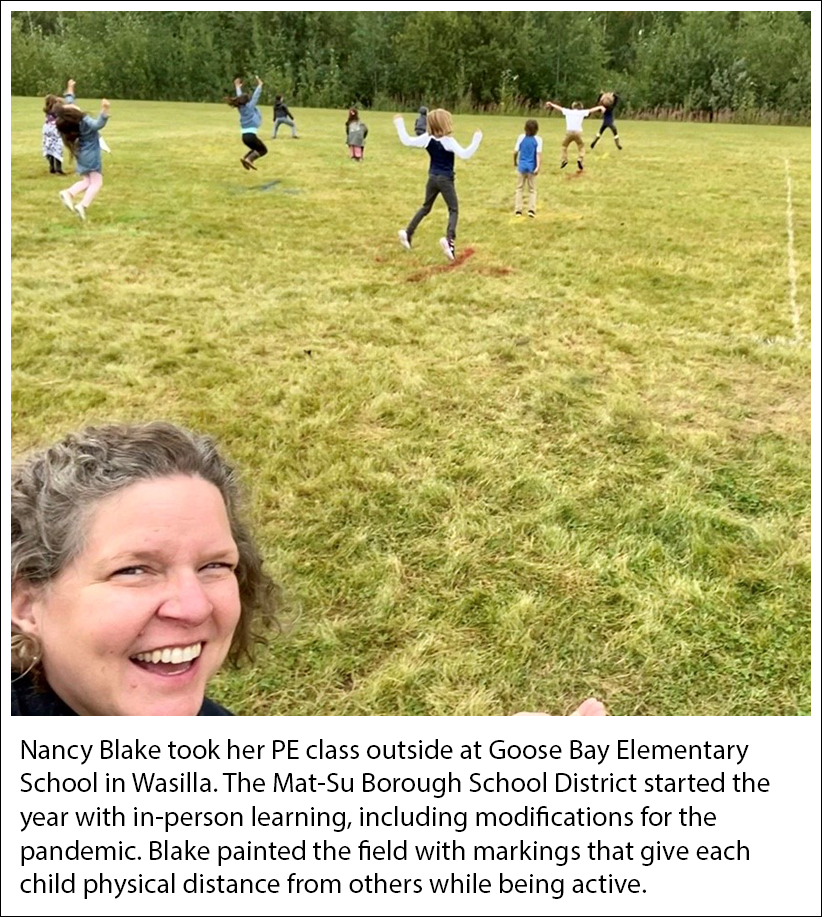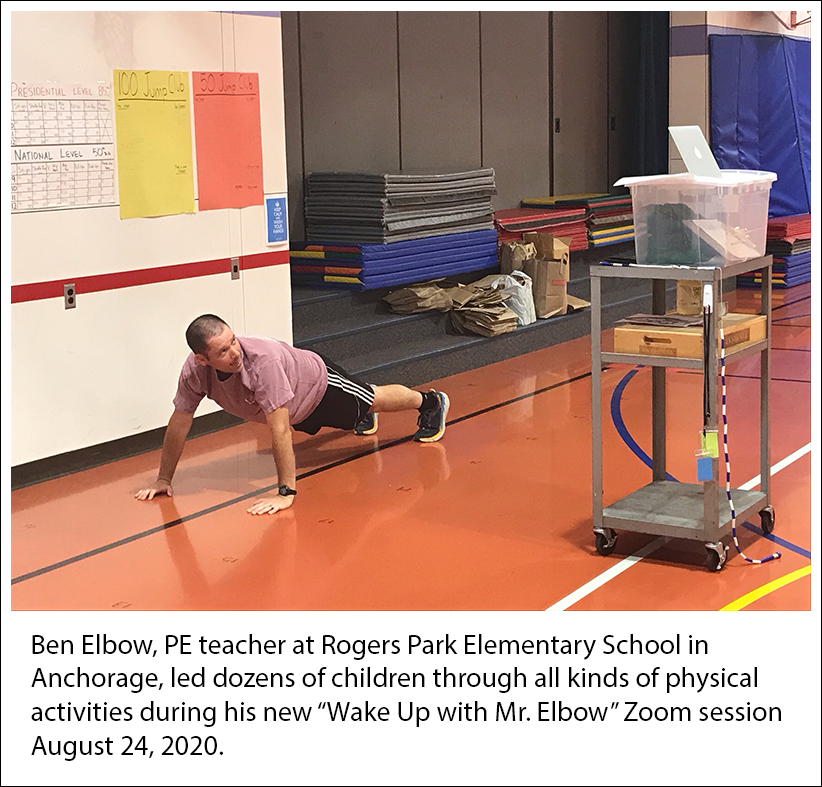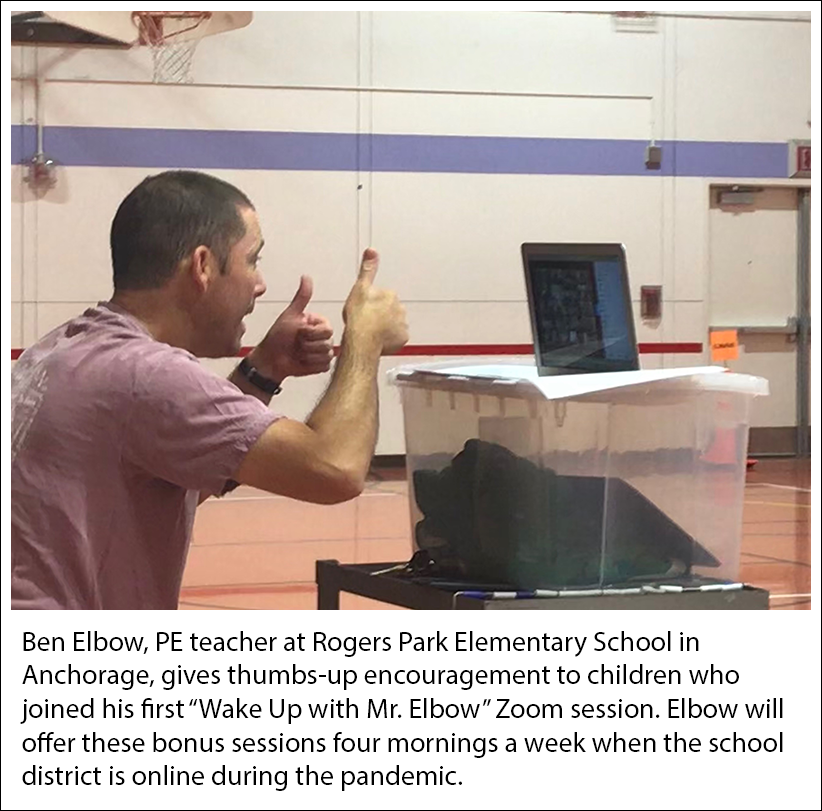Physical education teachers get creative to keep kids active this fall / blog update
Alaska Department of Health sent this bulletin at 08/27/2020 08:04 AM AKDTPhysical education teachers get creative to keep kids active this fall: Recreating gym space outdoors, moving in the mornings, and practicing skills with items found at home
AUGUST 27, 2020 — It was the first day back for Goose Bay Elementary School in Wasilla. Nancy Blake was excited. Kids were headed to her class, but they walked right past the gym. They didn’t put on their special gym shoes, either.

Instead, they walked outside in waterproof shoes, which is an unusual back-to-school item this year given the new focus on outdoor activities. They headed to their colored marking on the soccer field — red, yellow, blue or green. If they looked closely, they’d notice the newly painted field looked like the indoor gym space, just larger and outdoors. That was Blake’s plan when she bought a bunch of paint cans and went to work. This year, each child will get 16 feet by 12 feet of fresh air around them. That’s the whole point.
Schools across Alaska are finding ways to keep providing physical education (PE) class during a pandemic that has forced many changes to learning. Teachers are building lesson plans around physical distance, smaller cohorts, face coverings, online learning programs and more. Elementary-age kids in Wasilla and the rest of the Mat-Su Borough School District have started in person, but with many modifications. Blake’s modification is to hold PE class outside whenever possible, even in chilly temperatures down to 10 degrees below zero.
Thousands of children in some Alaska school districts are starting online instead, given higher levels of virus spreading in their communities. That’s why you found Ben Elbow connecting to Zoom at 8:30 a.m. this Monday morning. Elementary school is all online through the Anchorage School District (ASD), and PE teachers like Elbow have differing roles from school to school. Elbow is supporting a few classroom teachers at Rogers Park Elementary, but he’s also offering unique opportunities to keep kids moving.

Rogers Park kids are used to Elbow’s creativity. Ask any of them how to play Mr. Elbow Tag and they’ll get right to it. This year, he’s offering daily 30-minute Zoom PE classes. As a bonus, he’s starting their day with “Wake Up with Mr. Elbow.” For 30 minutes, he’ll lead Rogers Park families in activities. It’s meant for kids, but parents can join, too. He wants to build community, but he also wants parents to see this as something else if needed: This 30-minute session could give kids the activity they need, and at the same time help parents make breakfast, work or take on other tasks they’re juggling from home.
“What I’m also trying to do is help parents out,” said Elbow, a parent of two young children.
Keeping physical education and activity as priorities during a pandemic
Starting a school year during a pandemic means tough choices for everyone, from the school district administrators who need to plan for every possible scenario to parents weighing the new academic options in front of them. Each subject area is critical for well-rounded learning, but they’re all competing for priority with shorter school days in some districts and more limited class schedules.
While physical education is not always called a core subject area, teachers and district staff across Alaska see strong reasons to keep it included in the daily schedules for elementary-age kids, even when all learning is online. SHAPE America, the Society of Health and Physical Educators, issued guidance to keep PE and health as part of a complete education during the pandemic and a way to help children meet the national recommendation of 60 minutes or more of daily physical activity — regardless of learning in-person, online or both.
Some families learning from home have the time and resources to add in daily activity. Kayla Clark, PE teacher in Fairbanks, said other families don’t. For these families, the PE teacher could be the sole person providing activity for the child.
School districts across Alaska have PE teachers who are trained to teach children the skills of movement. Blake said she hopes districts will keep using those teachers to focus on that specialty, improving kids’ skills and keeping them active. Blake has gone online to learn from other PE teachers across the country. Jana DePriest, instructional coordinator for the Mat-Su Borough School District, said other Mat-Su PE teachers also did a lot of research to prepare this fall, and they’ve come with great ideas.
“As a profession, we’re up to this challenge,” said Blake, starting her 29th year of teaching. “It’s exciting to see.”
Anchorage PE teachers spent the summer recording online videos that focus on PE skills, which they then embedded into active slideshows, said Melanie Sutton, ASD’s Health and Physical Education Curriculum Coordinator. The slideshows, she said, were created by experts — the district’s trained PE teachers.
PE teachers say continuing to move is more important than ever now, given that time in front of a computer has gone up for everyone. Being active is critical to staying physically healthy. Activity also revs up the mind, Blake said. It helps kids focus when get they back to class, or when they get back to the desk or kitchen table at home.
“You handle stress better,” Blake said. “You can lessen anxiety.”
Providing in-person PE when that’s possible
Blake works in a district that can start teaching PE in person. The guidance in the Mat-Su Borough right now is to take PE outside when possible and to teach activities that can be done with distance, not contact, DePriest said. Blake said she can make these changes and still help kids have fun and meet goals.
Last year, Blake applied for a grant and purchased 30 bicycles that can be used to teach balance first and then pedaling. This year, Blake’s goal is to teach 5-, 6- and 7-year-olds how to ride a bike. When winter comes, she’ll introduce snowshoes.
“I want them to have fun and move,” Blake said. “I want them out, out, out every day. We live in Alaska. We’ve got to learn how to do that.”
The SHAPE America guidance recommends ways to support PE during the pandemic. Students should be allowed to wash their hands before and after PE class. Students and staff should be given hand sanitizer. SHAPE recommends that smaller cohorts of students engage in activity, and they should be active outside as much as possible. Water fountains should be turned off or regularly sanitized, and children should be encouraged to use their own water bottles. Teachers should use grids that mark boundaries and spacing, much like Blake created on the soccer field at Goose Bay Elementary.
Another best practice is to regularly clean equipment and high-touch surfaces. Blake is following that recommendation for bike-riding lessons. She said she plans to clean and disinfect the handlebars, seats and helmets after each use.
Providing PE online when facing higher risk levels
Districts like ASD and the Fairbanks North Star Borough School District are offering physical education remotely, at least for the beginning of the school year. Just like in-person PE, online-only PE will look different district by district, school by school.
ASD is providing options so that PE is consistently available for elementary students when it works best for the family to do it, Sutton said. Kids signed up for the blended school model will have access to these pre-recorded lessons focused on teaching PE skills. In these slideshows, ASD PE teachers demonstrate the skills from their homes or backyards. Kids can follow along whenever it works best for them. They can watch the slideshows over and over to improve their skills, Sutton said. Students even get to learn from PE teachers at other ASD schools, given that all of the district’s slideshows will be made available online.
Sutton said an ASD PE teacher took her daughter’s stuffed toys and arranged them during a slideshow. She then showed how she could navigate her way through the maze of toys. This type of movement is reality for many children learning and moving at home right now, Sutton said.
“We are teaching from where we are to where you are — using what we have available and what you have available — because we didn’t bring our gymnasiums home either,” she said.
Clark, who teaches PE at Woodriver Elementary in Fairbanks, also recorded skills-focused videos that kids can do at home. Through these videos, she teaches children how to strike a ball with a racket and juggle objects like grocery bags. When schools in Fairbanks start online this year, Clark said she plans to incorporate challenges to help students track their at-home activities, like running.
Districts offer differing amounts of PE each week
Even with all of these opportunities, the total amount of weekly PE minutes available to children may differ this school year compared to past years. All Mat-Su schools started in low- or medium-risk levels and are offering school days that are just as long as they were last year, DePriest said. Blake said that allows her to teach about as much PE time this year as last year.
Clark, in Fairbanks, said her school is offering a shorter day this year, like many schools across the state. Last year, she offered two PE sessions per week per classroom. This year, each classroom will get only one 30-minute session per week for each specialized subject, like PE and music, she said. If students come back to the classroom, recess will not be offered, but classroom teachers may take their students outside for movement breaks, Clark said.
The Petersburg School District in Southeast Alaska is starting its year with elementary students splitting the day into smaller cohorts that come to school in the morning or afternoon. They’ve hired additional classroom teachers to keep the cohorts smaller, said Ginger Evens, a teacher who coordinates Petersburg’s wellness grant. Elementary-age students will not receive any PE, music or art during the first month of school, but teachers are encouraged to get children outside when possible. They’ll also have 20 minutes of recess each day, offered in different areas outside the school to keep groups small. As the school year starts, the district is focused on integrating all subjects, but the focus is on reading, writing and math, Evens said. Some parents have shared concerns with the school board, saying they want kids to have PE during the school day. In an abundance of caution, the district is starting slowly and will revisit the decision and the risk level in Petersburg at the end of September, Evens said.
Connecting with kids through physical education
PE teachers have so many ideas they’re trying this year to keep kids moving. Some teachers, like Elbow, are offering additional live PE sessions when they’re teaching only online. Recording PE videos is necessary and important for learning, but so is building connections.
“That’s what we all miss,” Elbow said.
One of the best things he can offer during online learning, he said, is a teacher who’s live and in front of his students, even if that’s only through a computer camera.

“Teachers must make more of a concerted effort to connect when in a distance learning environment,” the SHAPE guidance states. “Students need to feel like part of their school community and that they are cared for in order to learn.”
This school year will be filled with hiccups and hurdles, as no one knows what risk level their community will be in next quarter or how their children will be learning months from now. PE teachers have ideas to keep kids moving, no matter what. By the last day of this challenging school year, Blake wants Goose Bay children to feel confident and strong. She wants students to believe they can try any activity and do it, and then challenge themselves to try and do the next thing.
“I would hope that I was able to make them know that I cared about them,” Elbow said, “and that I helped them find moments of joy while being active.”
Read the entire Play Every Day blog online.
Play Every Day is a campaign with the Alaska Department of Health and Social Services to help Alaska children grow up at a healthy weight and encourage families to be physically active and choose healthy drinks. For more information, visit www.playeveryday.alaska.gov.

